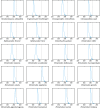Distributions of extinction times from fossil ages and tree topologies: the example of mid-Permian synapsid extinctions
- PMID: 34966586
- PMCID: PMC8667717
- DOI: 10.7717/peerj.12577
Distributions of extinction times from fossil ages and tree topologies: the example of mid-Permian synapsid extinctions
Abstract
Given a phylogenetic tree that includes only extinct, or a mix of extinct and extant taxa, where at least some fossil data are available, we present a method to compute the distribution of the extinction time of a given set of taxa under the Fossilized-Birth-Death model. Our approach differs from the previous ones in that it takes into account (i) the possibility that the taxa or the clade considered may diversify before going extinct and (ii) the whole phylogenetic tree to estimate extinction times, whilst previous methods do not consider the diversification process and deal with each branch independently. Because of this, our method can estimate extinction times of lineages represented by a single fossil, provided that they belong to a clade that includes other fossil occurrences. We assess and compare our new approach with a standard previous one using simulated data. Results show that our method provides more accurate confidence intervals. This new approach is applied to the study of the extinction time of three Permo-Carboniferous synapsid taxa (Ophiacodontidae, Edaphosauridae, and Sphenacodontidae) that are thought to have disappeared toward the end of the Cisuralian (early Permian), or possibly shortly thereafter. The timing of extinctions of these three taxa and of their component lineages supports the idea that the biological crisis in the late Kungurian/early Roadian consisted of a progressive decline in biodiversity throughout the Kungurian.
Keywords: Amniotes; Edaphosauridae; Extinction time; Fossil record; Fossilized-birth-death model; Mass extinction events; Ophiacodontidae; Permian; Permo-Carboniferous synapsids; Sphenacodontidae.
© 2021 Didier and Laurin.
Conflict of interest statement
The authors declare that they have no competing interests.
Figures








References
-
- Abdala F, Rubidge BS, Van Den Heever J. The oldest therocephalians (Therapsida, Eutheriodontia) and the early diversification of Therapsida. Palaeontology. 2008;51(4):1011–1024. doi: 10.1111/j.1475-4983.2008.00784.x. - DOI
-
- Alroy J. Constant extinction, constrained diversification, and uncoordinated stasis in North American mammals. Palaeogeography, Palaeoclimatology, Palaeoecology. 1996;127(1–4):285–311. doi: 10.1016/S0031-0182(96)00100-9. - DOI
-
- Alroy J. A simple Bayesian method of inferring extinction. Paleobiology. 2014;40(4):584–607. doi: 10.1666/13074. - DOI
-
- Alroy J, Marshall C, Miller A. The Paleobiology Database. 2012. https://paleobiodb.org/#/ https://paleobiodb.org/#/
-
- Amson E, Laurin M. On the affinities of Tetraceratops insignis, an Early Permian synapsid. Acta Palaeontologica Polonica. 2011;56(2):301–312. doi: 10.4202/app.2010.0063. - DOI
LinkOut - more resources
Full Text Sources

